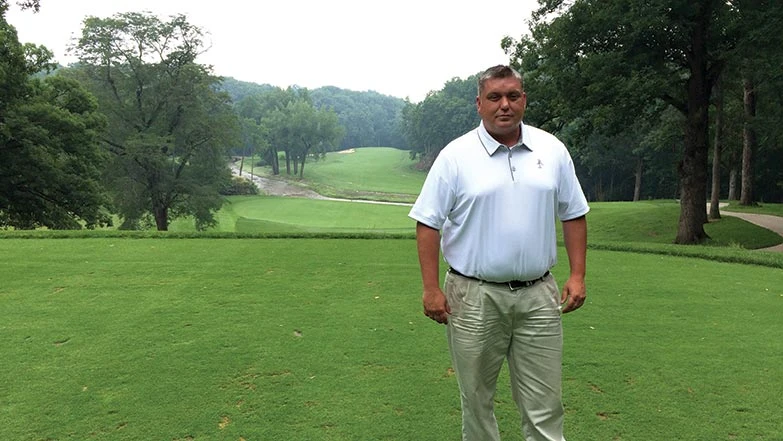
 Polishing an aging gem can yield jarring numbers, and director of agronomy Dean Sparks doesn’t seek a tablet, laptop or desktop when providing numerical evidence of the scope of work pursued at Davenport Country Club.
Polishing an aging gem can yield jarring numbers, and director of agronomy Dean Sparks doesn’t seek a tablet, laptop or desktop when providing numerical evidence of the scope of work pursued at Davenport Country Club.
One of the largest makeovers in the 91-year-old course’s history started Aug. 1, 2014 and ended May 29, 2015. Without prodding or hesitation during a course tour in early July, Sparks reveals from memory the equipment and materials used during the renovation: 1,100 semi-trucks to haul and 13 bulldozers to move 5,700 tons of USGA greens mix, 4,600 tons of sand and 2,000 tons of pea gravel. GCBAA-certified members involved in the renovation, Landscapes Unlimited and Leibold Irrigation, combined to bring nearly 150 workers to the Pleasant Valley, Iowa, site.
“It was massive,” Sparks says. “We redid greens, tees, regrassed all the fairways, redid the bunkers, most of the irrigation … Normally when I have done this before, we have been closed over a year. This we did in eight months. It was pretty spectacular how everything worked together. Guys did a great job. Both construction companies were great to work with.”
Before returning to his native Iowa, Sparks experienced multiple renovations as an employee in the TPC Network. He also worked with Pete Dye on projects at Crooked Stick Golf Club and the Pete Dye Course at French Lick Resort, a pair of highly regarded Indiana golf courses.
 Every renovation, though, features different dynamics, and the ability to work at a dizzying pace without sacrificing quality defined what transpired on the bluffs above the Mississippi River. Sparks arrived at Davenport in March 2014, well after architects Ron Forse and Jim Nagle had established a master plan for the club. Sparks carefully reviewed the plan after being hired and everybody associated with Davenport started entering renovation mode by June. When Forse and Nagle arrived in Iowa for the first day of construction, they didn’t need to search for personnel or materials. A staging area adjacent to the par-3 eighth hole had been established a month before the course closed.
Every renovation, though, features different dynamics, and the ability to work at a dizzying pace without sacrificing quality defined what transpired on the bluffs above the Mississippi River. Sparks arrived at Davenport in March 2014, well after architects Ron Forse and Jim Nagle had established a master plan for the club. Sparks carefully reviewed the plan after being hired and everybody associated with Davenport started entering renovation mode by June. When Forse and Nagle arrived in Iowa for the first day of construction, they didn’t need to search for personnel or materials. A staging area adjacent to the par-3 eighth hole had been established a month before the course closed.
Ideal construction weather greeted crews. The club didn’t receive any significant rainfall during the first five weeks of work, which allowed seeding to begin in September. “That was key,” Sparks says, “but the biggest thing was having everything staged and ready to go so we weren’t waiting on anything.”
College football represents one of Sparks’ non-work passions, and in some ways he resembled a coach who guided his team to a 21-0 lead in the first half of a season opener. He spent last August observing crews execute a plan to perfection.
“Dean spearheaded the preparation and we were in constant contact,” Forse says. “We felt like we had a really good plan, and I could tell this was going to be a really good course when it was done. That preparation was really key and Dean just did a great job pulling it together. He saved the club a ton of money because he knew how to work things.”
Sparks, like most solid football coaches, quickly credits others. “We had a great plan in place from Ron, which put us in position to be successful,” he says.

Forse calls the work at Davenport neither a restoration nor renovation, instead opting for the term “retro rebuild.” He describes a “retro rebuild” as a way of reestablishing a course’s identify while updating major course infrastructure.
Davenport presented desirable opportunities for all parties involved. For Sparks, this might have been the most personal project of his career because it occurred in his hometown and at a club where he envisions enjoying a long tenure. The project offered Forse and Nagle a rare chance to work on a course originally designed by renowned British architect Charles Alison, who designed less than 40 courses in the United States. The large scope of the work provided Landscapes Unlimited and Leibold with a forum to showcase their abilities to deliver quality work on tight deadlines. “It was high energy, high pressure,” Forse says.
Deadlines often spark the best work in talented and driven people guided by a supportive leadership. Seeing your entire golf course ripped apart isn’t for the meek, but a trusting membership like the one at Davenport allows creative minds to flourish, according to Forse.
The team Davenport assembled flipped a charming, classic golf course that hosted 1936 and ’51 Western Opens into a layout with the potential to host prominent events. Besides modernizing course infrastructure, the project expanded the level of detail found on every hole.
The greens had not been altered since a renovation in the early 1990s, according to Sparks, and improving drainage and creating more space for acceptable pin placements were goals. A member of the Landscapes Unlimited team used GPS technology to help return greens to the way Alison designed them. “They are subtle works of strategic art,” Forse says.
The greens were regrassed with .007 bentgrass, a variety touted for its dark green color and disease resistance. Fairways and tees were also converted to .007 while a turf-type fescue was established in the rough.
Parts of the course that require no grow-in – or even turf – underwent significant aesthetic and playability changes. The number of bunkers was reduced from 49 to 37, but fewer bunkers doesn’t equate to less sand on the course.
The right greenside bunker on the third hole is 14,000 square feet. The bunker is so big that crews place seven rakes around its periphery for members. Three holes later, golfers must negotiate – and crews must hand rake – a bunker measuring 10,000 square feet.

Forse and Nagle studied photographs and aerials of Alison’s work when designing the bunkers, which feature a jagged appearance. Inspiration for multiple bunkers at Davenport originated from Hirono Golf Club, a Japanese course considered to be one of Alison’s best designs. The bunkers don’t resemble the original ones at Davenport, but they fit the setting. “We brought in the highest form of Alison’s art that we know of into a course that didn’t originally have that,” Forse says, “but it fits.” The bunkers are also the scene of the course’s flattest lies, according to Sparks.
Forse spends most of his working time enhancing older courses, and he says he doesn’t remember a cold-weather project accomplishing as much in such a short period as Davenport. “The challenge was the pressure,” he says. “We wanted to do it perfectly in a short amount of time. I’m so happy. Jim and I are elated, because it was a big team effort with us. We are really elated. The have their old course back, but better.”
And, according to Sparks, others looking to achieve a similar feat need can rely on old, yet proven, tactics. “I think the key to a golf course renovation is preparation,” Spark says. “If you are really ready to go when the project starts, that eliminates a lot of the problems. Having the materials on site, making sure the architect is there when you are going to need him that way he can make the decisions he needs to make when you are going through the project … All of that is really important.”
Guy Cipriano is GCI’s assistant editor.

Explore the October 2015 Issue
Check out more from this issue and find your next story to read.
Latest from Golf Course Industry
- From the publisher’s pen: Conscientious of a bigger role
- Bernhard and Company partners with Laguna Golf Phuket
- Terre Blanche showcases environmental stewardship
- VIDEO: Introducing our December issue
- Bernhard and Company introduces Soil Scout
- Nu-Pipe donates to GCSAA Foundation’s Centennial Campaign
- GCSAA enhances golf course BMP tool
- Melrose leadership programs sending 18 to 2026 GCSAA Conference and Trade Show





